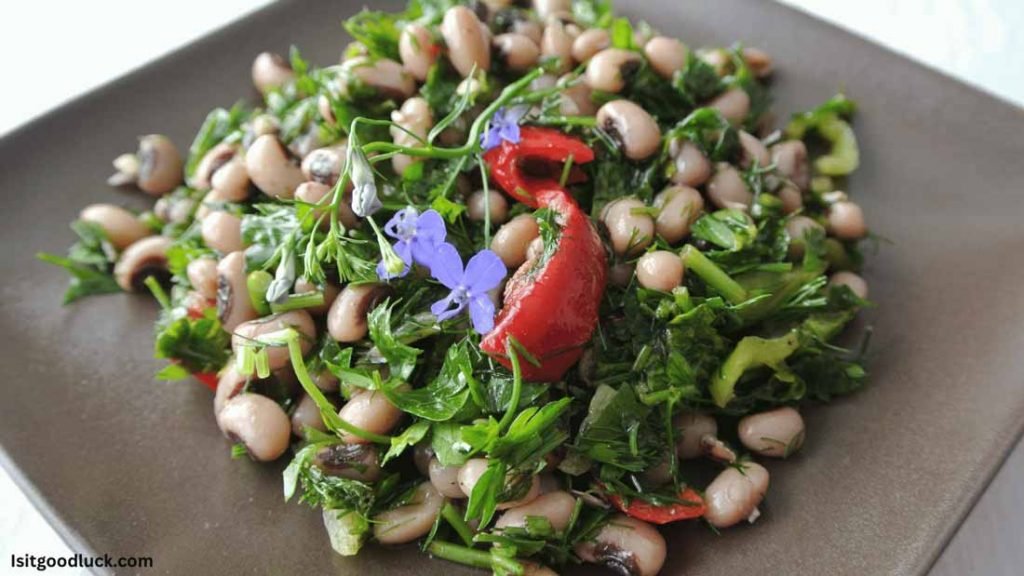Traditions play a crucial role in the cultural identity of every society. An amalgamation of beliefs, practices, rituals, and customs, they lend a distinct character to every culture.
A fascinating aspect of these traditions is the food associated with them. Certain foods are often consumed to mark special occasions, bringing together people to celebrate cultural norms.
One such rule is eating black-eyed peas on New Year’s Day, which is especially popular in the South of the United States.
Believed to attract good luck and prosperity in the new year, this ritual carries deep symbolism and a rich historical backdrop.
Contents
- 1 The Historical Significance of Black-Eyed Peas:
- 2 Is it Good Luck to Eat Black-Eyed Peas on New Year’s?
- 3 Other Good-Luck Foods of New Year’s Day
- 4 Black-eyed Peas: A Global Tradition
- 5 Conclusion:
- 6 FAQs
- 6.1 What is the significance of eating black-eyed peas on New Year’s Day?
- 6.2 Can eating black-eyed peas on New Year’s Day guarantee good luck?
- 6.3 Are black-eyed peas the only food associated with good luck on New Year’s Day?
- 6.4 Are there any specific ways to prepare black-eyed peas for good luck?
- 6.5 Is the tradition of eating black-eyed peas on New Year’s Day limited to the United States?
The Historical Significance of Black-Eyed Peas:
The tradition of eating black-eyed peas on New Year’s Day has roots that dig deep into history. One prevalent theory suggests it originated during the Civil War era.
Black-eyed peas, a staple food for enslaved people, were thought to usher in good luck and ensure survival through the harsh winter months.
Another perspective attributes its origin to African folklore. Black-eyed peas in several African cultures are associated with money and prosperity.
With the brutal transportation of enslaved people to the Americas, these culinary traditions found their way to the New World, contributing to the cultural mosaic that defines America today.

Is it Good Luck to Eat Black-Eyed Peas on New Year’s?
Black-eyed peas carry deep symbolism associated with wealth, abundance, and new beginnings, strengthening their status as a good luck charm.
The coin-like shape of these peas is seen as a representation of wealth. The dark hue of the pea symbolizes the earth, a source of fertility and abundance. The white ‘eye’ of the pea mirrors the sun, a beacon of new beginnings.
The method of preparing these peas also bears symbolic importance. Frequently cooked with greens like collard or mustard greens, the pairing signifies wealth (peas) and prosperity (greens).
Also read: Is it good luck to spill sugar?
Other Good-Luck Foods of New Year’s Day
Beyond black-eyed peas, several other food items carry auspicious symbolism on New Year’s Day:
- Cornbread: A symbol of gold, the consumption of cornbread is said to promise financial prosperity in the coming year.
- Hoppin’ John: This dish, made from black-eyed peas, rice, and pork, is a triple threat, promising good luck in all spheres of life.
- Collard Greens: Greens, resembling paper money, are believed to usher in financial prosperity.
- Cabbage: The eating of cabbage, symbolizing wealth, promises economic prosperity.
Black-eyed Peas: A Global Tradition
The ritual of eating black-eyed peas on New Year’s Day isn’t confined to the United States. Still, it is practiced in Mexico, Brazil, and Caribbean countries, reflecting the global resonance of this culinary tradition.
There are myriad ways to cook these peas, with ham hocks or bacon being a favorite addition, offering a rich flavor profile to the dish.
These versatile peas can be consumed as a main dish, a side dish, or even as a salad. They are a popular ingredient in soups and stews, with every region having its unique take on the preparation.
Besides their symbolic importance, black-eyed peas are a nutritional powerhouse packed with protein, fiber, and iron and rich in vitamins A and C.
Conclusion:
The age-old tradition of consuming black-eyed peas on New Year’s Day persists in the modern world.
While no empirical evidence supports the idea of these peas bringing good luck, the belief endures, not just because of the hopes of prosperity it embodies but for the sense of continuity and shared cultural experience it offers.
Whether for good luck, a delicious meal, or to keep traditions alive, black-eyed peas remain a popular feature on the New Year’s Day menu.
Also read other articles regarding foods good luck
FAQs
What is the significance of eating black-eyed peas on New Year’s Day?
Eating black-eyed peas on New Year’s Day is believed to bring good luck and prosperity for the coming year. It is a tradition passed down through generations in many cultures. The peas are considered symbolic of wealth, abundance, and new beginnings.
Can eating black-eyed peas on New Year’s Day guarantee good luck?
While no scientific evidence supports the idea that eating black-eyed peas on New Year’s Day guarantees good luck, the tradition continues to be practiced because it is deeply rooted in cultural beliefs and serves as a way to hope for positive outcomes in the new year.
Are black-eyed peas the only food associated with good luck on New Year’s Day?
Black-eyed peas are not the only food associated with good luck on New Year’s Day. In addition to black-eyed peas, other foods are traditionally eaten to invite good luck and prosperity. Eating cabbage on new year is also considered to bring good luck.
Are there any specific ways to prepare black-eyed peas for good luck?
There are various ways to prepare black-eyed peas for good luck. The most common method involves cooking them with ham hocks or bacon, which adds flavor and richness to the dish.
Is the tradition of eating black-eyed peas on New Year’s Day limited to the United States?
No, the tradition of eating black-eyed peas on New Year’s Day is not limited to the United States. It is also practiced in other countries and cultures, such as Mexico, Brazil, and various countries in the Caribbean.








